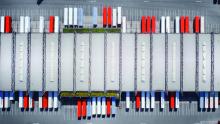Tech
|
19 Nov 2021
Dead reckoning: Clearing up 7 key misconceptions
Untethered or automotive? Either way, you win.

Without dependable positioning technology, the rise of the smart mobility solutions we are seeing hit the roads in cities around the world today would be unthinkable. Just imagine e-scooter operators trying to round up their fleets of scooters without technology to guide them. And it isn’t just e-scooters. Accurate positioning technology is transforming traditional markets too, such as car rental, fleet management, and vehicle insurance, as well as other new ones, including bike sharing, ride hailing, and pay-as-go-drive road tolling.
It is, however, somewhat ironic that the very environments in which these applications are growing fastest are among the most challenging for accurate positioning solutions. Within densely built-up cities, vehicles often lie beyond direct line of sight of the global navigation satellite system (GNSS) satellites their positioning solutions depend on: inside deep urban canyons, driving under bridges or in tunnels, or in multi-level parking lots. And even when they aren’t, their GNSS receivers can pick up signals that reach them indirectly, e.g., after bouncing off buildings, negatively impacting their position estimate.
Because inaccurate or interrupted positioning performance affect service quality, operational efficiencies, billing, and compliance monitoring, they are bad for business. It isn’t surprising, therefore, that more and more business are turning to positioning solutions that address these pain points. Key among them: dead reckoning.
What are dead reckoning solutions?
Dead reckoning (DR) solutions use inertial sensors – gyroscopes and accelerometers – to complement GNSS-based positioning technology. Untethered dead reckoning solutions continuously measure the accelerations acting on the vehicle and monitor changes to its orientation. Using sensor fusion techniques, they then blend their data with GNSS measurements to compute an improved position output in real-time. Automotive dead reckoning solutions go one step further, integrating an additional input coming from the vehicle’s wheel tick sensor to achieve an even more accurate result.
The top three benefits of dead reckoning technology are becoming increasingly well known:
• Up to 3 times more accurate positioning data in urban scenarios
• Continued tracking when GNSS signals are interrupted
• Tracking and navigation from the first meter driven based on the last saved position
Still, talking to customers, we see that several misconceptions continue to persist. In this blog, we’ll take a look at the top seven and try to clear them up, once and for all.
#1 Automotive dead reckoning is only for automotive applications
The myth: As the name suggests, automotive dead reckoning is only for automotive applications.
The reality: In addition to fusing GNSS with inertial sensor data, ADR solutions feed-in the vehicle speed information from a hardware wheel tick sensor or via messages coming through the software interface. Since it was first introduced, ADR has come a long way. Today, it can be applied to a range of vehicle types. Our latest dead reckoning modules include dynamic models for cars, motorcycles, and e-scooters.
#2: Dead reckoning only helps with full GNSS signal loss
The myth: Dead reckoning solutions only benefits solutions when GNSS signals are completely obstructed.
The reality: In addition to bridging gaps in GNSS signal coverage, dead reckoning solutions support positioning solutions in a variety of challenging scenarios:
• By offering a complementary source of relative positioning, dead reckoning solutions mitigate positioning errors caused by multipath effects.
• They can help detect and mitigate the impact of GNSS jamming and spoofing.
• When the position fix is temporarily lost, dead reckoning solutions can help keep positioning errors small.
#3: The rise of dual-band GNSS makes dead reckoning unnecessary
The myth: Dual-band GNSS receivers offer sufficient positioning performance on their own.
The reality: It is true that dual-band GNSS receivers improve positioning accuracy under certain conditions. That said, dual-band GNSS does nothing to mitigate the loss of tracking when GNSS signals are interrupted. Dead reckoning uniquely bridges these gaps and ensures 100% position availability.
#4: Dead reckoning isn’t worth its cost
The myth: Dead reckoning solutions add to the BOM cost without a clear ROI.
The reality: While dead reckoning solutions do come with a slightly higher price tag (still typically below a 50 percent markup), their payoff starts on day one and continues throughout the lifetime of the vehicle. In use cases that depend on accurate vehicle tracking for billing, DR technology ensures that mileage is tracked even when GNSS service is unavailable. When accurate position data contributes to operational efficiency (for example to locate and collect abandoned e-scooters), DR technology translates to time savings and fuel savings.
#5: Dead reckoning is difficult to set up
The myth: Setting up dead reckoning solutions is much more difficult to set up than standard GNSS solutions.
The reality: There is some truth to this, but the reality is more nuanced. The increased sophistication of GNSS receivers – their ability to track multiple satellite constellations on several frequency bands – has enabled improved positioning performance at the cost of increased complexity. The same is true for dead reckoning solutions. The alignment of the dead reckoning receiver needs to be accurately determined and specified for reliable performance. Additionally, ADR solutions need to connect to the vehicle’s sensors to track the wheel’s rotations.
Depending on the use case, there are, however, ways to simplify installation, e.g., the auto-alignment feature that is available for car-like use cases, i.e., four-wheel vehicles. We will soon be publishing user guides covering best practices and mistakes to avoid, so stay tuned!
#6: Dead reckoning can make up for poor GNSS signal levels
The myth: Use cases that operate in areas with constant poor GNSS signal coverage can improve their performance using dead reckoning solutions.
The reality: It is true that dead reckoning can help when GNSS signal levels are poor or interrupted for a limited amount of time. However, systems with consistently poor signal levels will have limited position accuracy. Because GNSS signals are also used to calibrate the inertial and wheel-tick sensors, poor GNSS accuracy will limit the quality of the calibration, ultimately leading to reduced position accuracy when having to rely on the sensors.
To improve performance, the root cause of the problem needs to be addressed. In the case of poor antenna placement, two remedial measures are selecting a better antenna and increasing the ground plane. When there is excessive RF interference, a SAW filter can improve sensitivity. And when a passive antenna is used, adding an LNA to the design can fix the problem.
#7: Untethered dead reckoning is the poor man’s automotive dead reckoning
The myth: Untethered dead reckoning is a second-rate solution that stands in the shadow of automotive dead reckoning.
The reality: The origin of this perception is easy to understand. Rather than benchmarking the performance of UDR and ADR against GNSS-only solutions, it uses ADR as the benchmark. We would argue that this gets it backwards. Both UDR and ADR represent valuable upgrades to GNSS-only solutions. The biggest value-add ADR offers over UDR is increased position accuracy in the event of long outages, i.e., those that last for more than a minute.
What’s more, with our latest NEO-M9V dead reckoning module, you don’t have to choose between the two. The module supports both UDR and ADR out of the box, giving you maximum flexibility to adapt your solution architecture to a variety of use cases.
Untethered or automotive? Either way, you win.
Dead reckoning positioning solutions are finding their way into more and more applications, for good reason: With urban use cases on the rise, satellite-based positioning technology is being pushed to its limits to deliver the performance people and businesses have come to expect. At the same time, users have become less tolerant of positioning errors, especially when they impact their safety, their time, or their bottom line.
At u-blox, we offer a broad portfolio of industry-leading dead reckoning solutions for automotive and industrial applications, developed working hand in hand with customers driving innovation in solutions that leverage dead reckoning technology. Constant confrontation with their pain points in design-in, implementation, and deployment has made this a journey a process of continuous improvement, allowing us to accumulate invaluable expertise which we’ve fed into our highly refined solutions.
We just announced the u-blox NEO-M9V, our first u-blox positioning receiver to offer both untethered dead reckoning (UDR) and automotive dead reckoning (ADR). NEO-M9V is a perfect fit for fleet management and micromobility applications that require reliable meter-level positioning accuracy even in challenging GNSS signal environments such as urban canyons. Offering both UDR and ADR on the same module offers unique flexibility to defer the decision on whether to use the easy-to-integrate UDR technology or the more sophisticated ADR technology for maximum flexibility, allowing our customers to provide the best solution case-by-case to each of their end-customers.
Head over to related resources to learn more about dead reckoning technology and our new NEO-M9V. To find out how we can support your use case, reach out to the salesperson closest to you or fill out a project information form.
Mathias Vetter
Principal Product Manager, Consumer and Industrial Tracking



